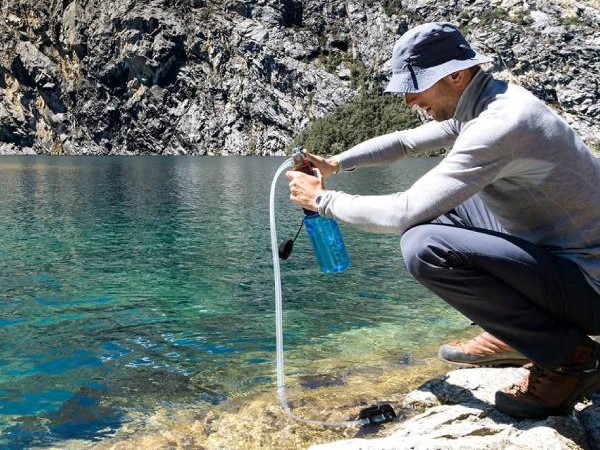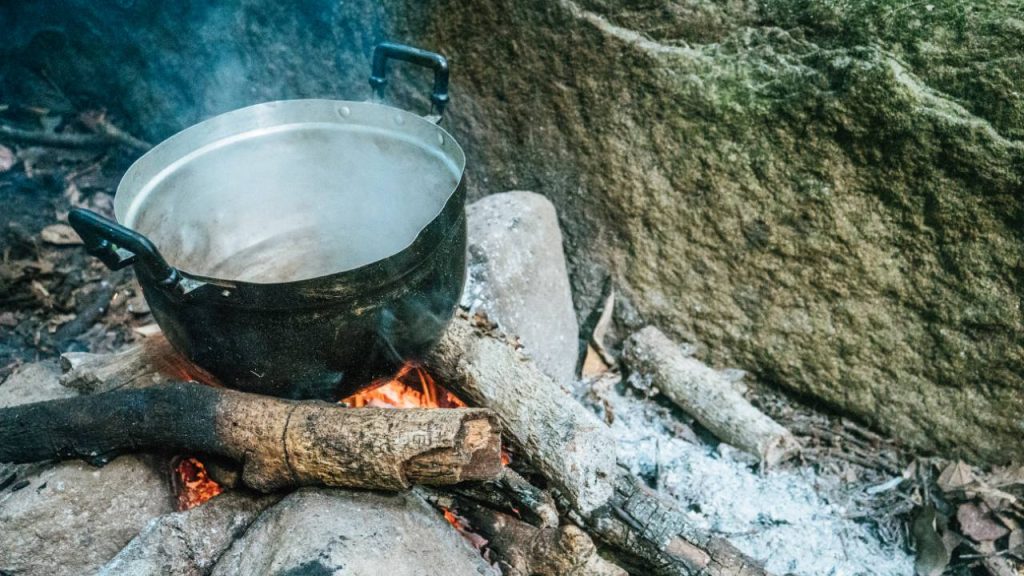Some campgrounds rely on treated municipal water, while others use natural sources like wells, which may be unsafe to drink. To be cautious, assume the water isn’t potable and prepare to purify it yourself. Various methods will be explained below, ensuring clean water wherever you camp.
No, campground water is not safe to drink. Unless a campground official confirms it, use purification methods: filters, tablets, or boiling for drinking water.
In fact, for shorter trips, bringing your own water can be a smart choice. You can use large 5-gallon jugs, which are refillable at stores. Before departing, these jugs can be filled with water from your home’s system, typically providing enough water for a week or longer, depending on the season.
A 5-gallon jug of filtered water is also handy to have. If your supply runs low while traveling in your camper van, finding a store to refill your jugs with clean water is a straightforward task.
However, it’s important to consider that this approach may not be suitable for everyone. It demands extra storage space and may not be feasible if you have a small camper or a large family with high water consumption. Nevertheless, for brief trips, it’s worth contemplating the acquisition of a sizable container for safe drinking water.
5 Ways to Filter Campground Water
Here are five ways you can follow to make the campground water potable:
Carry Portable Filter
Portable filters are valuable tools when you need to purify campground water for drinking, especially if you’re uncertain about its quality or treatment. However, it’s essential to understand that not all portable water filters are created equal. Many of these filters are capable of eliminating disease-causing parasites like Cryptosporidium and Giardia from drinking water.
To ensure the effectiveness of your water filter in purifying your water, consider the following factors:
- Fine Pore Size: Your water filter should have a fine pore size to effectively filter out viruses, pathogenic bacteria, and pesticides.
- NSF Certification: Opt for a filter that is NSF-certified, with a filter pore size small enough to remove parasites such as Giardia and Cryptosporidium. It’s important to note that most portable water filters do not remove viruses, and many do not remove bacteria either.
- Follow Manufacturer’s Instructions: Always read and carefully follow the manufacturer’s instructions for the specific water filter you are using to ensure proper usage.
- Disinfection: After filtering the water, consider adding a disinfectant like iodine, chlorine, or chlorine dioxide to the filtered water. This step is crucial for killing any remaining viruses and bacteria.

Boil It
One of the simplest and most effective methods to ensure access to clean water, especially when you’re in outdoors or in a situation where safe bottled water is unavailable, is by boiling water from a readily accessible source (excluding saltwater).
Whether you have access to a heating source or a portable camping stove with propane or butane gas, this method is quite straightforward. You’ll need things like, a water pot or a suitable container for boiling water, a portable camping stove powered by propane or butane gas.

To make water safe for drinking, follow these steps:
- Fill your pot or container with water sourced from the environment.
- Bring the water to a rolling boil.
- Allow it to boil for at least one minute.
- Let the boiled water cool.
Boiling water for a minimum of one minute effectively eliminates any germs, bacteria, or pathogens that may have been present. Once the water has cooled, you’ll have a cup of clean, safe water ready to enjoy. This method provides a reliable way to obtain potable water in various situations. If you have any questions or need further guidance, please feel free to ask.
Using Ultraviolet Light (UV Light)
UV light, also known as ultraviolet light, can effectively eliminate certain germs in water. Portable devices are available that dispense a measured amount of UV light to disinfect small quantities of clear water. It’s important to note that UV light is less effective when used with cloudy water, as small particles can block the light and prevent proper disinfection.
If the water appears cloudy, you should first filter it through a clean cloth, paper towel, or coffee filter, or alternatively, let it settle. Afterward, carefully separate the clear water and disinfect it using UV light. Always adhere to the manufacturer’s instructions for the UV device to ensure proper use and safety.
Solar Disinfection
In emergency situations, sunlight can be harnessed to enhance water quality. This method can help reduce the presence of some germs in water. To disinfect water using solar energy:
Fill clean and transparent plastic bottles with clear water. It’s important to note that solar disinfection is less effective when applied to cloudy water due to the potential blockage of germs by suspended particles.
If the water is cloudy, initially filter it through a clean cloth, paper towel, or coffee filter, or allow it to settle. Subsequently, separate the clear water and subject it to solar disinfection.
Lay the bottles horizontally in direct sunlight for 6 hours (on sunny days) or 2 days (on cloudy days). Positioning the bottles horizontally maximizes exposure to the sun’s rays, enhancing the water’s disinfection process.
Placing the bottles on a dark surface can further improve the effectiveness of the sun’s rays in disinfecting the water inside the bottles.
Water Purifying Tablets
Chlorine dioxide tablets are equipped with silver ions that effectively eliminate bacteria. They are designed to be added directly to water, although some individuals opt to use them after the water has passed through a filter.
One notable advantage of this purification method is its ability to enhance the taste of water, which may not be the case with the previous two methods. These tablets are available in various sizes, each tailored to treat specific water volumes.
Here are some key guidelines:
- Follow Manufacturer’s Instructions: Always adhere to the manufacturer’s instructions provided on the label or within the packaging.
- Effective Germ Elimination: Chlorine dioxide tablets can effectively kill germs, including Cryptosporidium, when used correctly in accordance with the manufacturer’s instructions.
- Caution with Iodine Tablets: It’s worth noting that iodine tablets or tablets containing tetracycline hydroperoxide can kill most germs but are not effective against Cryptosporidium. Additionally, water disinfected with iodine is not recommended for pregnant women, individuals with thyroid issues, or those with known iodine sensitivities. Prolonged use (more than a few weeks at a time) is also discouraged.
How to Identify Contaminated Water?
If you have concerns about the safety of your campground’s drinking water, there are a few ways to identify any contaminants. Once you’ve pinpointed the issues, you’ll be better prepared to select the appropriate filtration method for your specific situation.
There are several visual cues to watch for that may indicate your water is not suitable for consumption:
- Cloudy Appearance: Clear drinking water is the norm. If your water looks cloudy, refrain from drinking it. Purified water should be free of visible minerals, which are typically measured in parts per billion and should be invisible to the naked eye.
- Sediment: While some sediment can naturally end up in your water supply due to its source (e.g., water tables, wells, or reservoirs), effective water treatment should remove most of it. Visible sediment in your water may signal a break in the water main, allowing sediment to mix with treated water.
- Brown or Orange Hue: Water with a brown or orange hue often indicates an excess of iron or manganese. This can result from mining, excavation near water sources, or rusty water pipes.
- Oily Film: The presence of an oily film on standing water in sinks, toilets, or tubs suggests oil or grease in your water supply. Potential causes include water main leaks, inadequate water treatment, or insufficient filtration.
- Chlorine Scent: Chlorine is commonly added to drinking water to eliminate bacteria. While low levels are safe, excessive chlorine during the treatment process can lead to intestinal distress and health issues, detectable by a strong chlorine odor during use.
- Sulfur Scent: Traces of sulfur are normal in underground water supplies due to natural occurrences. Low levels pose minimal risks, but high sulfur content can be harmful. The strong, unpleasant odor resembling rotten eggs is a clear sign of elevated sulfur levels. This odor is often confused with bacteria, but disinfection can usually eliminate it.
- Metallic Taste: Clean drinking water should be tasteless. A metallic or bitter taste could indicate the presence of harmful substances, such as medications, pesticides, or industrial chemicals.
- Rusted Silverware: Silverware that tarnishes or rusts is a sign of excessive iron in your water. While water with a natural color is less likely to contain toxic iron levels, it can lead to rusting of pipes and faucets over time.
Frequently Asked Question
What does potable water mean in camping?
Potable water refers to the water that’s safe to drink. Non-potable water is not safe for drinking and should never be used to fill your onboard tank(s). It’s only suitable for tasks like rinsing tanks and cleaning the dump hose, but never for drinking.
Can one drop of contaminated water make you sick?
In most cases, a single droplet typically doesn’t pose much harm. To experience symptoms, a substantial quantity of these organisms usually needs to be present in your digestive system. If you’re elderly or have a weakened immune system, a smaller amount might be sufficient.

Diana Miller, is a dedicated nature enthusiast and an outdoor adventurer. She began leading groups for excursions in her teens and never stopped. Following her passion for nature, she gathers her friends for outdoor trips every now and then. And for the last 10 years, she has executed workshops on backpacking, snow kayaking and traveling that included her main motive of lightweight packing while outdoors. During leisure, she loves planning for her next adventure.









Leave a Comment